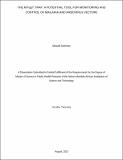The mtego® trap: a potential tool for monitoring and control of malaria and arbovirus vectors
Abstract
Odour-baited traps are valuable for vector surveillance and control; however, they often exhibit
varying recapture rates among mosquito species due to the limited range of host cues they provide.
Therefore, it is crucial to develop more effective traps capable of capturing a variety of mosquito
species. One potential alternative is the MTego trap, which incorporates thermal stimuli as
additional cues. This study aimed to evaluate the efficacy of the MTego trap for sampling different
mosquito species in a semi-field system. To conduct the experiments, fully balanced Latin square
design experiments were conducted in semi-field chambers using laboratory-reared female
Anopheles gambiae, Anopheles funestus, Anopheles arabiensis, Culex quinquefasciatus, and
Aedes aegypti mosquitoes. Fifty mosquitoes of each species were released in each chamber for 16
days. The evaluated traps included the MTego trap baited with PM6 (MT-PM6), the MTego trap
baited with BG-Lure (MT-BGL), and the BGP trap baited with BG-Lure (BGP-BGL). In addition,
the performance of the traps was compared to the human landing catch (HLC). The MTego traps
(MT-PM6 and MT-BGL) captured a similar proportion of Anopheles gambiae and Anopheles
funestus, and Aedes aegypti as the BGP-BGL. However, the traps did not match the performance
of HLC against all mosquito species. The study underscores the promising application of the
MTego trap as a monitoring and control tool for malaria and arbovirus vectors.

